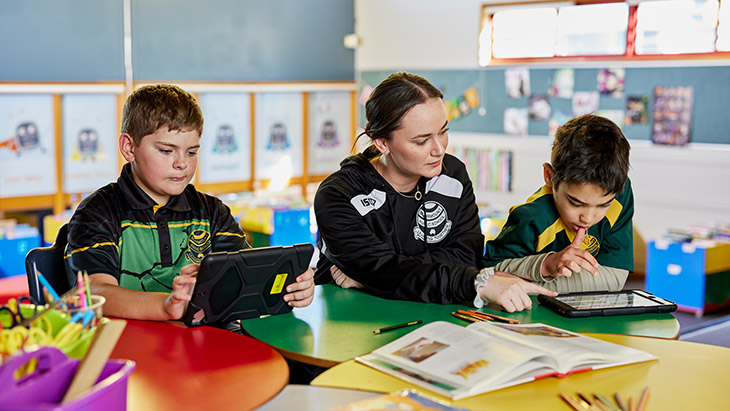Curriculum considerations for autism
Creative arts
Students on the autism spectrum may find loud noises during music and dance or some textures in art overwhelming.
Consider providing choices regarding activities and materials, and a quiet space or noise-reducing headphones may help some students.
English
Some students may need support with reading comprehension. Consider using a story map for important story elements such as the main characters, setting, beginning, middle, end.
Ask comprehension questions and provide prompts that increase in support when needed. For example, start with an open question, and move to a choice of two options if needed. Tactile and visual supports that link to the story and encourage student interaction may also be helpful.
Some students on the autism spectrum find pronouns (a word that replaces a person or object, such as I, me, or you) challenging. This is possibly because students on the autism spectrum often echo other people’s speech and have trouble understanding the social rules of language. They may need help to identify the pronouns when reading.
Provide lots of time to practise. Students on the autism spectrum may need help to use strategies or skills they learned in one task in a new task.
Languages
Students on the autism spectrum who have communication challenges may need support with learning a new language.
Assess whether learning a language will be of advantage to them on a case-by-case basis.
If they are learning a language, focus on areas of strength and build from there.
Mathematics
Some students on the autism spectrum may find it difficult to connect an image of a number with ‘how many’ (the quantity) it represents.
Dots or lines indented into a written or printed number can help them learn by pointing to or touching each dot or line to count ‘how many’.
Students on the autism spectrum may need help to use strategies or skills they learned in one task in a new task.
Provide effective feedback and provide lots of opportunities to practise.
Personal development, health and physical education
Students may learn a new movement skill more easily if they are given a picture card of that skill just before they start practising. Give them one picture card at a time if learning several new skills.
It may help to pair a student who is finding it hard to learn a new skill with a student who can help them learn that skill. The other student can help break down instructions, model a skill, and affirm for correct attempts.
Consider adjustments to communication style and tailor activities to be as inclusive as possible.
Science and technology
Students on the autism spectrum may need help to use theory or skills they learned in one task in a new task.
Some students on the autism spectrum may have much knowledge in an area of the science curriculum if it is one of their special interests. This can give them an opportunity to share their knowledge with their peers.
Many students enjoy digital technology and will be motivated by this subject.
Some students on the autism spectrum may have much knowledge about technology if it is one of their special interests. This can give them an opportunity to share their knowledge with others.
Human society and environment
Some students on the autism spectrum may have much knowledge in an area of the humanities curriculum if it is one of their special interests. This can give them an opportunity to share their knowledge with others.
